Lifestyle
André 3000 Drops Surprise Album After Met Gala Piano Statement

It can be a challenge to make an impression on the Met Gala’s red carpet, especially when the competition includes Diana Ross wearing a feathered overcoat with an 18-foot-long train, Bad Bunny toting a bag fit for a bowling ball, and Rihanna arriving fashionably late — with a baby bump.
But there are spectacles and there are spectacles, and André 3000 fit nicely into the latter category when he showed up to the festivities on Monday night with a grand piano strapped to his back.
“I’m sorry,” the actress Natasha Lyonne said while being interviewed on the red carpet, “there’s a piano coming.”
It was a statement piece and a nifty bit of marketing by André 3000, a rapper and musician whose appearance at the Metropolitan Museum of Art’s Costume Institute Benefit coincided with the release of his new album, “7 Piano Sketches,” which he described in an Instagram post as “improvisations” and included a drawing of himself in a version of his Met Gala outfit. The instrumental piano album follows one in which he focused entirely on the flute — a sharp departure from his days in the rap duo Outkast.
Beyond the promotion of his new album, his outfit on Monday was carefully planned, both to highlight the event’s theme, which centered on Black style and dandyism, and its dress code, “Tailored For You.”
The piano was undeniably bespoke. Created by the design and fabrication company Pink Sparrow, it was modeled after a Steinway Model S Baby Grand piano, which weighs nearly 600 pounds. But Pink Sparrow’s version was “reimagined” at 75 percent scale, the company said in a statement. It was made of foam, a thin type of plywood and 3-D elements to weigh only 30 pounds, complete with straps and pedals.
Still, André 3000 made sure to emphasize the illusion of its heft by donning a workwear-inspired jumpsuit that he said was a collaboration between Burberry and his newly revived fashion brand, Benji Bixby, which used to be known as Benjamin Bixby.
He also carried what appeared to be a black garbage bag.
The stylist Law Roach worked with Burberry on the musician’s look. In a red carpet interview, he implied that the musician had worn the piano in the car on the way to the event.
“Dandyism is an everyday thing,” André 3000 said in an interview after his arrival. “It’s an attitude when you wake up. We’ve been doing it for years. You know, I’m just happy that there’s a night that puts a spotlight on it. And we’re just here to have fun doing what we do.”
He did not wear the piano all night. After his red carpet appearance, he removed it in a separate room in the Great Hall of the Metropolitan Museum and made a wardrobe change, slipping into a black number with a heart stitched in the chest. The outfit was another Benji Bixby and Burberry collaboration, he said.
Will Welch, GQ’s editor in chief, also wore Benji Bixby.
“At this point,” André 3000 said as he prepared to enter the gala itself, “it’s all about just getting together and sitting at tables and talking and actually seeing some of your friends. The hard part is done.”
A weight, in other words, had been lifted off his back.
Callie Holtermann contributed reporting.

Lifestyle
In Brooklyn’s Park Slope neighborhood, children’s entertainment comes with strings

The Tin Soldier, one of Nicolas Coppola’s marionette puppets, is the main character in The Steadfast Tin Soldier show at Coppola’s Puppetworks theater in Brooklyn’s Park Slope neighborhood.
Anh Nguyen for NPR
hide caption
toggle caption
Anh Nguyen for NPR
Every weekend, at 12:30 or 2:30 p.m., children gather on foam mats and colored blocks to watch wooden renditions of The Tortoise and the Hare, Pinocchio and Aladdin for exactly 45 minutes — the length of one side of a cassette tape. “This isn’t a screen! It’s for reals happenin’ back there!” Alyssa Parkhurst, a 24-year-old puppeteer, says before each show. For most of the theater’s patrons, this is their first experience with live entertainment.
Puppetworks has served Brooklyn’s Park Slope neighborhood for over 30 years. Many of its current regulars are the grandchildren of early patrons of the theater. Its founder and artistic director, 90-year-old Nicolas Coppola, has been a professional puppeteer since 1954.
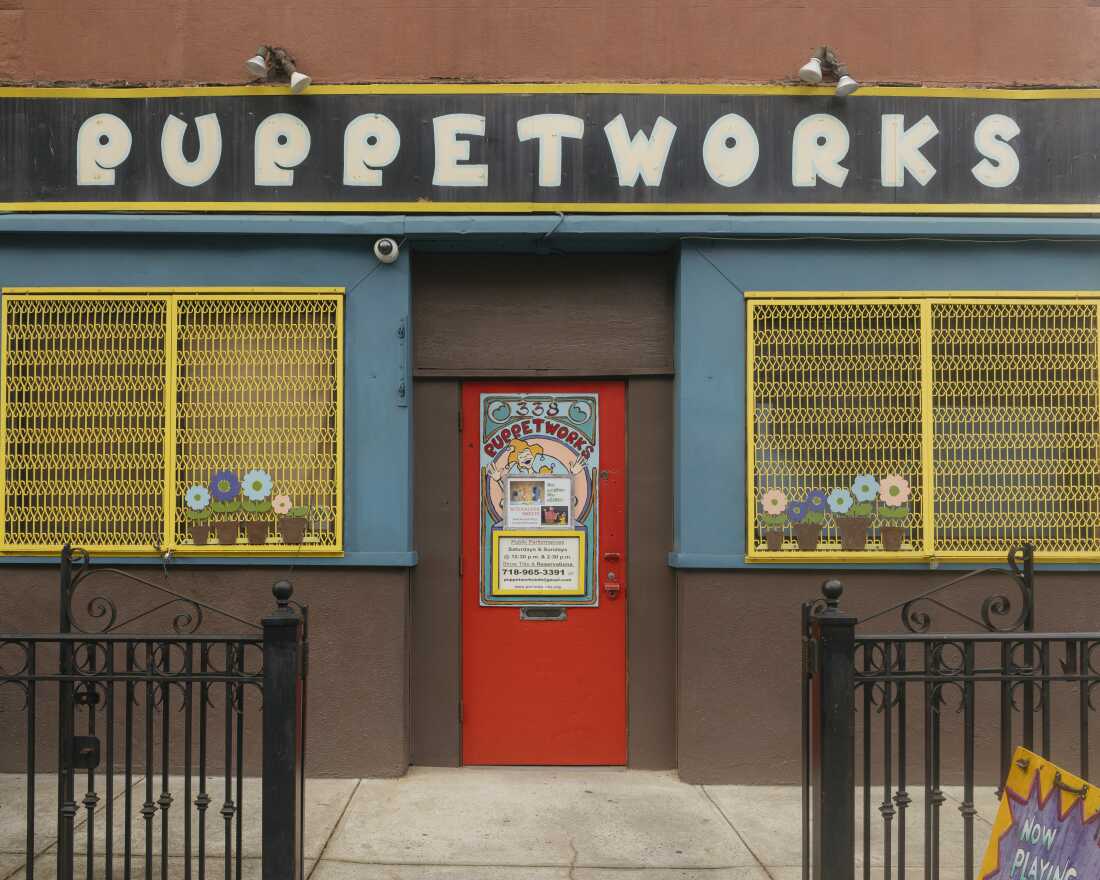
The Puppetworks theater in Brooklyn’s Park Slope neighborhood.
Anh Nguyen for NPR
hide caption
toggle caption
Anh Nguyen for NPR

A workshop station behind the stage at Puppetworks, where puppets are stored and repaired.
Anh Nguyen for NPR
hide caption
toggle caption
Anh Nguyen for NPR
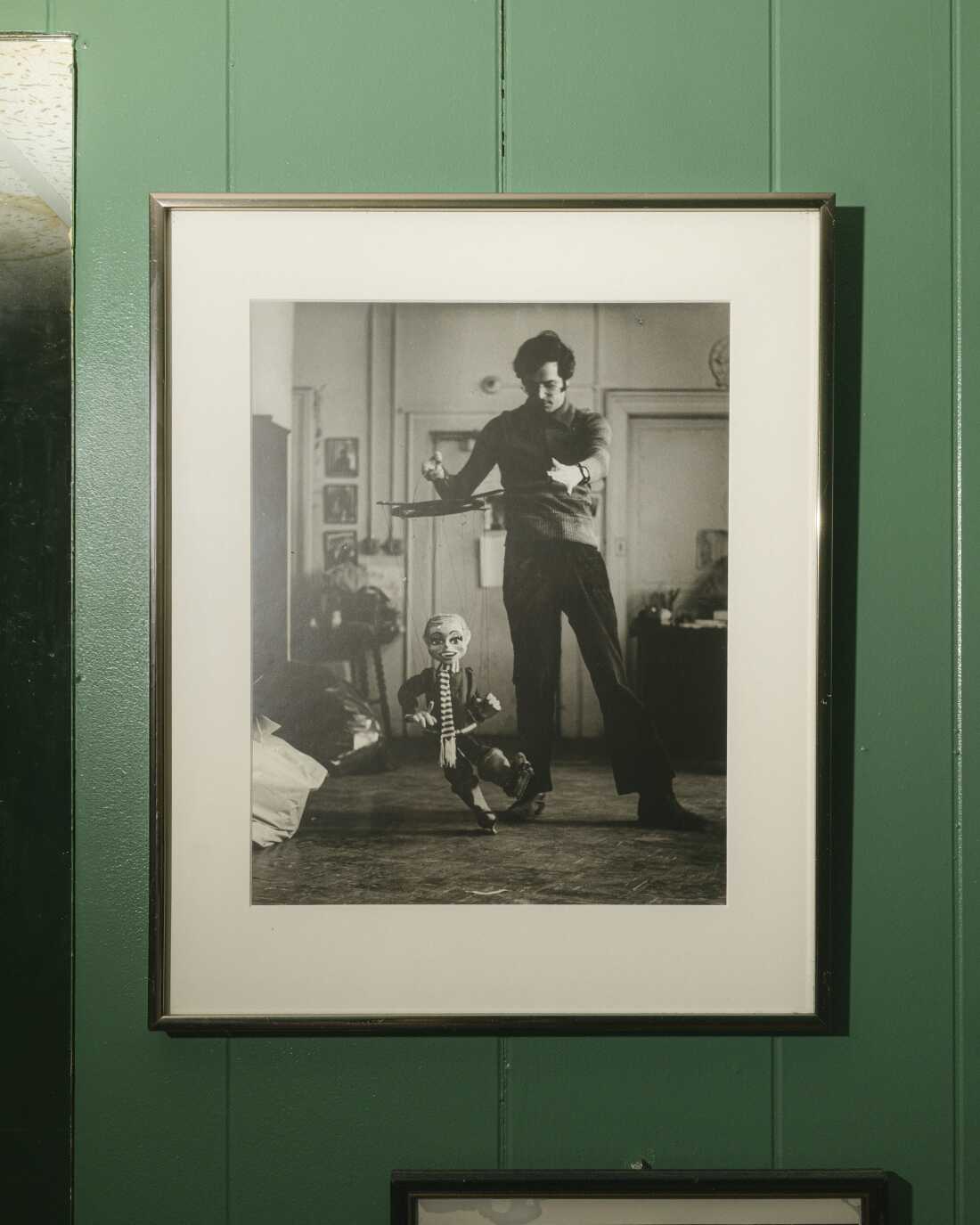
A picture of Nicolas Coppola, Puppetworks’ founder and artistic director, from 1970, in which he’s demonstrating an ice skater marionette puppet.
Anh Nguyen for NPR
hide caption
toggle caption
Anh Nguyen for NPR
For just $11 a seat ($12 for adults), puppets of all types — marionette, swing, hand and rod — take turns transporting patrons back to the ’80s, when most of Puppetworks’ puppets were made and the audio tracks were taped. Century-old stories are brought back to life. Some even with a modern twist.
Since Coppola started the theater, changes have been made to the theater’s repertoire of shows to better meet the cultural moment. The biggest change was the characterization of princesses in the ’60s and ’70s, Coppola says: “Now, we’re a little more enlightened.”

Right: Michael Jones, Puppetworks’ newest puppeteer, poses for a photo with Jack-a-Napes, one of the main characters in The Steadfast Tin Soldier. Left: A demonstration marionette puppet, used for showing children how movement and control works.
Anh Nguyen for NPR
hide caption
toggle caption
Anh Nguyen for NPR

Marionette puppets from previous Puppetworks shows hang on one of the theater’s walls.
Anh Nguyen for NPR
hide caption
toggle caption
Anh Nguyen for NPR

A child attends Puppetworks’ 12:30 p.m. showing on Saturday, Dec. 6, dressed in holiday attire that features the ballerina and tin soldier in The Steadfast Tin Soldier.
Anh Nguyen for NPR
hide caption
toggle caption
Anh Nguyen for NPR
Streaming has also influenced the theater’s selection of shows. Puppetworks recently brought back Rumpelstiltskin after the tale was repopularized following Dreamworks’ release of the Shrek film franchise.
Most of the parents in attendance find out about the theater through word of mouth or school visits, where Puppetworks’ team puts on shows throughout the week. Many say they take an interest in the establishment for its ability to peel their children away from screens.
Whitney Sprayberry was introduced to Puppetworks by her husband, who grew up in the neighborhood. “My husband and I are both artists, so we much prefer live entertainment. We allow screens, but are mindful of what we’re watching and how often.”

Left: Puppetworks’ current manager of stage operations, Jamie Moore, who joined the team in the early 2000s as a puppeteer, holds an otter hand puppet from their holiday show. Right: A Pinocchio mask hangs behind the ticket booth at Puppetworks’ entrance.
Anh Nguyen for NPR
hide caption
toggle caption
Anh Nguyen for NPR
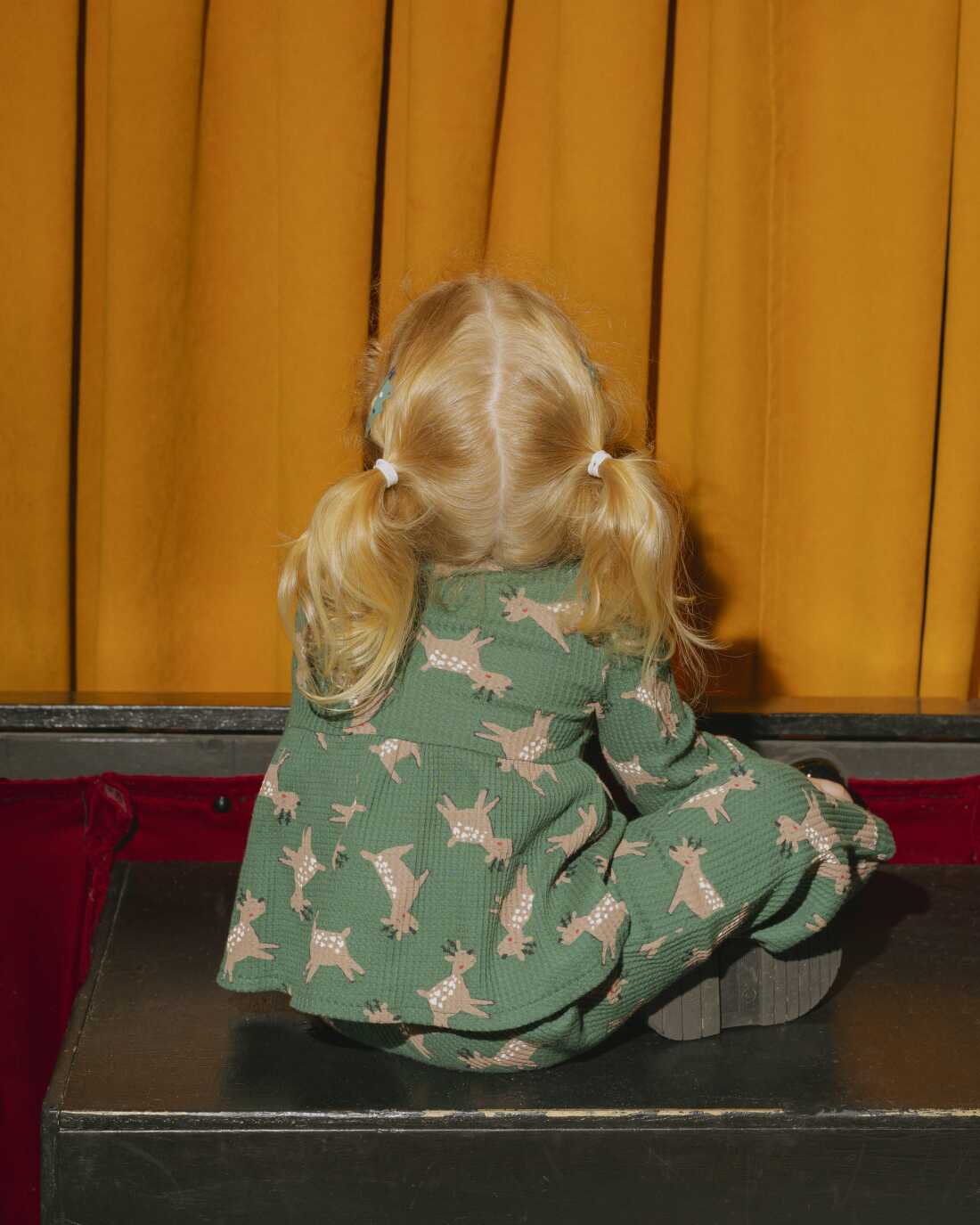
A child attends Puppetworks’ 12:30 p.m. showing on Saturday, Dec. 6, dressed in holiday attire.
Anh Nguyen for NPR
hide caption
toggle caption
Anh Nguyen for NPR

Left: Two gingerbread people, characters in one of Puppetworks’ holiday skits. Right: Ronny Wasserstrom, a swing puppeteer and one of Puppetworks’ first puppeteers, holds a “talking head” puppet he made, wearing matching shirts.
Anh Nguyen for NPR
hide caption
toggle caption
Anh Nguyen for NPR
Other parents in the audience say they found the theater through one of Ronny Wasserstrom’s shows. Wasserstrom, one of Puppetworks’ first puppeteers, regularly performs for free at a nearby park.
Coppola says he isn’t a Luddite — he’s fascinated by animation’s endless possibilities, but cautions of how it could limit a child’s imagination. “The part of theater they’re not getting by being on the phone is the sense of community. In our small way, we’re keeping that going.”

Puppetworks’ 12:30 p.m. showing of The Steadfast Tin Soldier and The Nutcracker Sweets on Saturday, Dec. 6.
Anh Nguyen for NPR
hide caption
toggle caption
Anh Nguyen for NPR
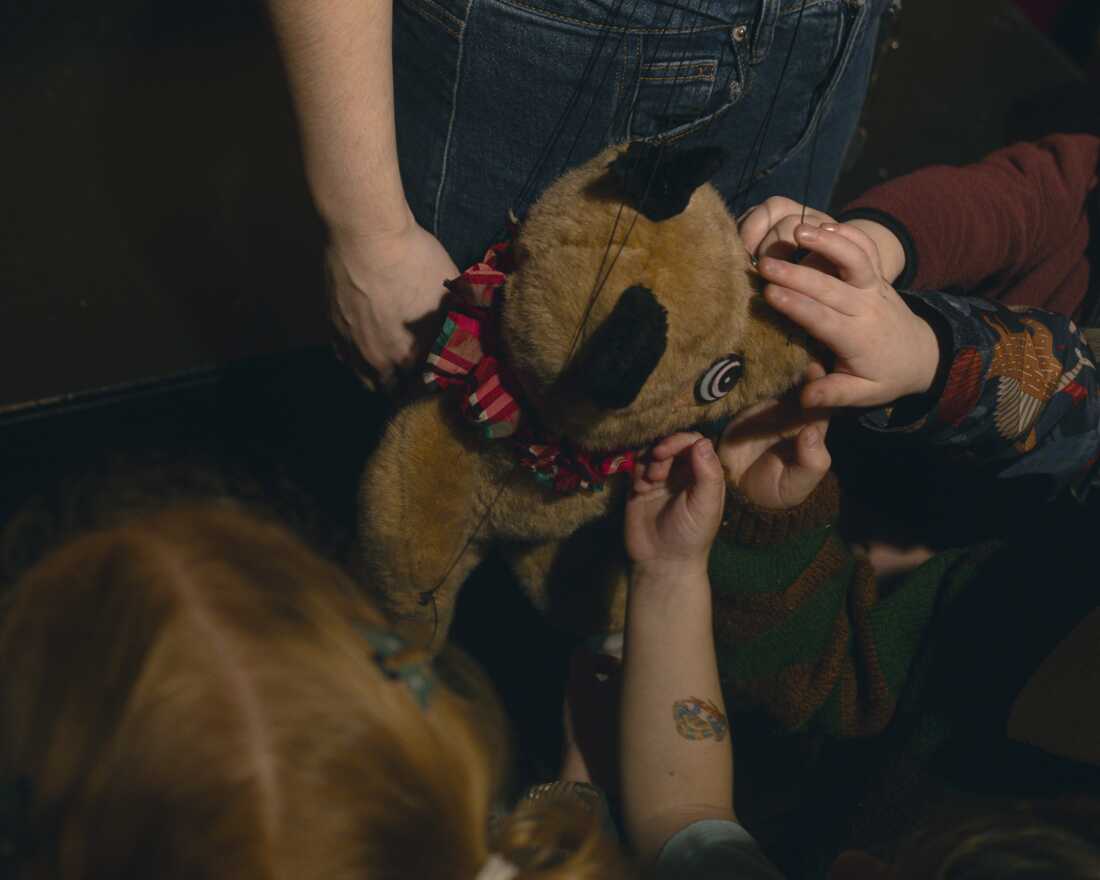
Children get a chance to see one of the puppets in The Steadfast Tin Soldier up close after a show.
Anh Nguyen for NPR
hide caption
toggle caption
Anh Nguyen for NPR
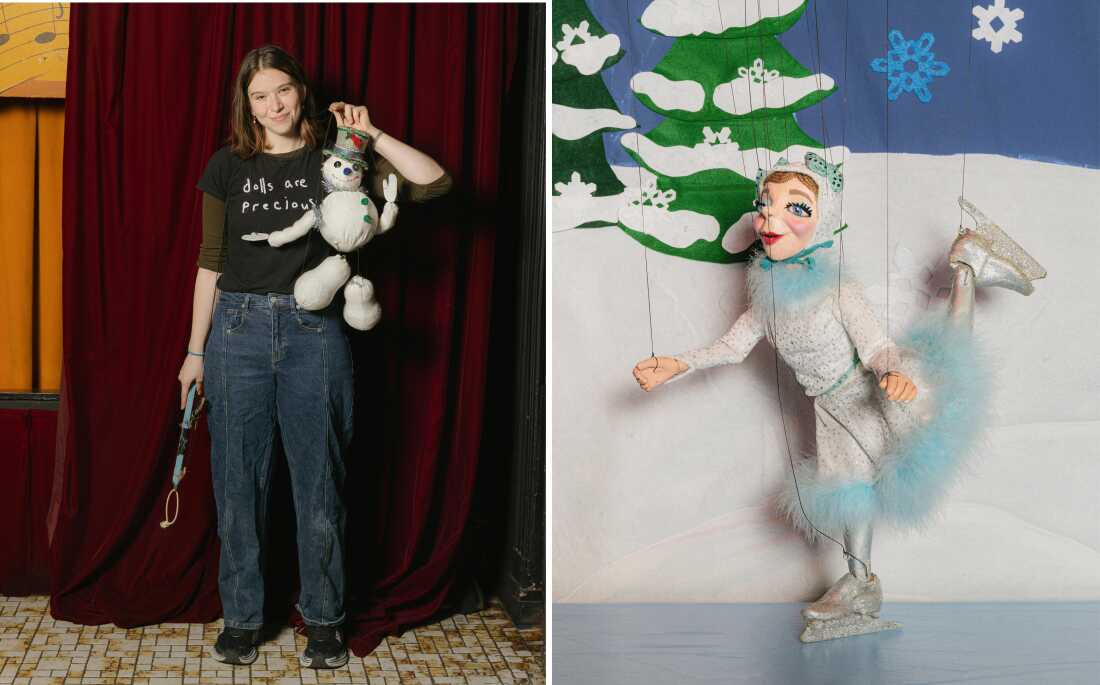
Left: Alyssa Parkhurst, Puppetworks’ youngest puppeteer, holds a snowman marionette puppet, a character in the theater’s holiday show. Right: An ice skater, a dancing character in one of Puppetworks’ holiday skits.
Anh Nguyen for NPR
hide caption
toggle caption
Anh Nguyen for NPR
Community is what keeps Sabrina Chap, the mother of 4-year-old Vida, a regular at Puppetworks. Every couple of weeks, when Puppetworks puts on a new show, she rallies a large group to attend. “It’s a way I connect all the parents in the neighborhood whose kids go to different schools,” she said. “A lot of these kids live within a block of each other.”

Three candy canes — dancing characters in one of Puppetworks’ holiday skits — wait to be repaired after a show.
Anh Nguyen for NPR
hide caption
toggle caption
Anh Nguyen for NPR
Anh Nguyen is a photographer based in Brooklyn, N.Y. You can see more of her work online, at nguyenminhanh.com , or on Instagram, at @minhanhnguyenn. Tiffany Ng is a tech and culture writer. Find more of her work on her website, breakfastatmyhouse.com.
Lifestyle
The Best of BoF 2025: Fashion’s Year of Designer Revamps

Lifestyle
Best Christmas gift I ever received : Pop Culture Happy Hour

-

 Iowa1 week ago
Iowa1 week agoAddy Brown motivated to step up in Audi Crooks’ absence vs. UNI
-

 Maine1 week ago
Maine1 week agoElementary-aged student killed in school bus crash in southern Maine
-

 Maryland1 week ago
Maryland1 week agoFrigid temperatures to start the week in Maryland
-

 New Mexico1 week ago
New Mexico1 week agoFamily clarifies why they believe missing New Mexico man is dead
-

 South Dakota1 week ago
South Dakota1 week agoNature: Snow in South Dakota
-

 Detroit, MI1 week ago
Detroit, MI1 week ago‘Love being a pedo’: Metro Detroit doctor, attorney, therapist accused in web of child porn chats
-

 Health1 week ago
Health1 week ago‘Aggressive’ new flu variant sweeps globe as doctors warn of severe symptoms
-

 Maine1 week ago
Maine1 week agoFamily in Maine host food pantry for deer | Hand Off






















